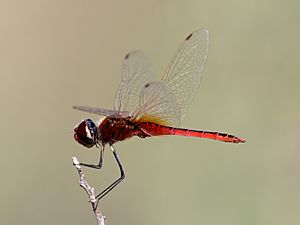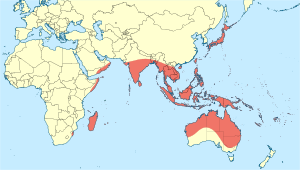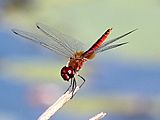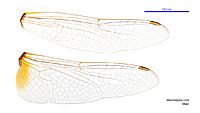Coastal glider facts for kids
Quick facts for kids Coastal glider |
|
|---|---|
 |
|
| Male | |
 |
|
| Female | |
| Conservation status | |
| Scientific classification | |
 |
|
| Synonyms | |
|
Macrodiplax cora, also known as the coastal glider, is a cool type of dragonfly. You might also hear it called the wandering pennant or Cora’s pennant. These amazing insects belong to a family of dragonflies called Libellulidae.
Contents
What Does It Look Like?
A grown-up male coastal glider is a medium-sized dragonfly. It's about 45 millimeters (1.8 inches) long. Its wings can spread out to about 75 millimeters (3 inches).
Male vs. Female Gliders
Male coastal gliders have a bright red body, called an abdomen. Each part of their abdomen has black patches on top. Female gliders are not as brightly colored. Their bodies are usually duller.
Body and Wings
The middle part of their body, called the thorax, is brownish. Sometimes, it can be a bit hairy. Their wings are mostly clear. However, they have a yellowish spot near the base of their back wings.
How to Spot Them
It's easy to tell coastal gliders apart from other red dragonflies. Look for their two-colored legs. Also, notice the black patches on their abdomen. These patches often look like an hourglass shape.
Where Do They Live?
Coastal gliders are found in many places. They live across tropical Asia and Australasia. This includes countries in South Asia and Australia. You can also find them on many islands in the Indian and Pacific Oceans.
Traveling Dragonflies
These dragonflies love to travel! They often move from one place to another. This means they don't stay in one spot for long. They are known for their long journeys.
Favorite Hangouts
Coastal gliders prefer to live near water. They especially like places like coastal lagoons. You can also find them in estuaries, where rivers meet the sea. Swamps are another favorite spot. They can even handle a bit of salt in the water.
Gallery







